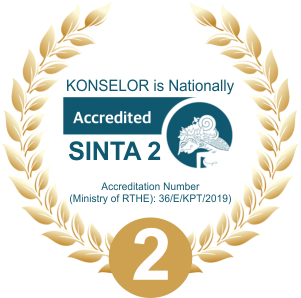The effect of schema therapy and schema-focused mindfulness therapy on marital communication of Iranian women in Malaysia
 ), Wan Marzuki Wan Jaafar(2), Siti Aishah Hassan(3), Sidek Mohd Noah(4),
), Wan Marzuki Wan Jaafar(2), Siti Aishah Hassan(3), Sidek Mohd Noah(4), (1) Department of Counsellor Education and Counselling Psychology, Faculty of Educational Studies, Universiti Putra Malaysia, Kuala Lumpur, Malaysia
(2) Department of Counsellor Education and Counselling Psychology, Faculty of Educational Studies, Universiti Putra Malaysia, Kuala Lumpur, Malaysia
(3) Department of Counsellor Education and Counselling Psychology, Faculty of Educational Studies, Universiti Putra Malaysia, Kuala Lumpur, Malaysia
(4) Department of Counsellor Education and Counselling Psychology, Faculty of Educational Studies, Universiti Putra Malaysia, Kuala Lumpur, Malaysia
 Corresponding Author
Corresponding Author
Copyright (c) 2019 Maysitoh Maysitoh
DOI : https://doi.org/10.24036/0201983106103-0-00
Full Text:
 Language : en
Language : en
Abstract
The aim of this study is to evaluate the effectiveness of schema therapy and schema-focused mindfulness therapy on marital communication among Iranian married women who lived in Malaysia from 2015 to 2016. The qualified participants were assigned randomly into three groups, i.e. two experimental groups which in order received schema therapy and schema-focused mindfulness therapy, and a control group which did not receive any treatment. The treatment sessions lasted nearly three months using marital satisfaction subscale from the ENRICH questionnaire, a demographic questionnaire and Young's schema questionnaire as the instruments. Two-way repeated measures ANOVA and ANCOVA were also employed for data analysis. The findings of the study revealed that schema therapy and schema-focused mindfulness therapy had a significant effect on marital communication of Iranian women in Malaysia. Moreover, the findings showed more improvement for schema-focused mindfulness therapy group at two months follow-up.
References
AhmadiGatab, T., & Khamen, A. B. Z. (2011). Relation between communication skills and marital-adaptability among university students. Procedia-Social and Behavioral Sciences, 30, 1959-1963.
Baucom, D. H., Epstein, N., Daiuto, A. D., Carels, R. A., Rankin, L. A., & Burnett, C. K. (1996). Cognitions in marriage: The relationship between standards and attributions. Journal of Family Psychology, 10(2), 209.
Bradbury, T. N., & Lavner, J. A. (2012). How can we improve preventive and educational interventions for intimate relationships? Behavior Therapy, 43(1), 113-122.
Burleson, B. R. (1992). Taking communication seriously. Communications Monographs, 59(1), 79-86.
Burleson, B. R., & Denton, W. H. (1997). The relationship between communication skill and marital satisfaction: Some moderating effects. Journal of Marriage and the Family, 884-902.
Fox, N., Hunn, A., & Mathers, N. (2009). Sampling and sample size calculation. East Midlands/Yorkshire: the National Institutes for Health Research. Research Design Service for the East Midlands/Yorkshire & the Humber.
Ghoroghi, S., Hassan, S. A., & Baba, M. (2012). Function of Family-of-Origin experiences and marital adjustment among married Iranian students of Universiti Putra Malaysia. International Journal of Psychological Studies, 4(3), 94.
Gottman, J. M., & Silver, N. (2015). The seven principles for making marriage work: A practical guide from the country's foremost relationship expert: Harmony.
Greene, J. O., & Burleson, B. R. (2003). Handbook of communication and social interaction skills: Psychology Press.
Griffin, W. A., & Greene, S. M. (2013). Models of family therapy: The essential guide: Routledge.
Habil, M. H. (2002). Psychiatric Morbidity of Migrant Workers in Malaysia-For iRPA Study on Health Problems of Foreign Worker. Journal of Health and Translational Medicine, 7(1), 62-66.
Karney, B. R., & Gauer, B. (2010). Cognitive complexity and marital interaction in newlyweds. Personal Relationships, 17(2), 181-200.
Madanian, L., Mansor, S. M. S. S., & bin Omar, A. H. (2013). Marital satisfaction of Iranian female students in Malaysia: a qualitative study. Procedia-Social and Behavioral Sciences, 84, 987-993.
Malaklolunthu, S., & Selan, P. S. (2011). Adjustment problems among international students in Malaysian private higher education institutions. Procedia-Social and Behavioral Sciences, 15, 833-837.
Mosavi, S. E., & Mahmud, Z. (2016). Describe Marital Satisfaction in the Couples Interview among Immigrant Iranian in Malaysia. South journal of Educational Psychology and Counseling, 3(2).
Myers-Walls, J. A., Frias, L. V., Kwon, K.-A., Ko, M.-J. M., & Lu, T. (2011). Living life in two worlds: Acculturative stress among Asian international graduate student parents and spouses. Journal of Comparative Family Studies, 42(4), 455-478.
Oei, T. P., & Baranoff, J. (2007). Young Schema Questionnaire: Review of psychometric and measurement issues. Australian Journal of Psychology, 59(2), 78-86.
Riso, L. P., du Toit, P. L., Stein, D. J., & Young, J. E. (2007). Cognitive schemas and core beliefs in psychological problems: A scientist-practitioner guide: American Psychological Association.
Shirpak, K. R., Maticka-Tyndale, E., & Chinichian, M. (2011). Post migration changes in Iranian immigrants’ couple relationships in Canada. Journal of Comparative Family Studies, 42(6), 751-770.
Siffert, A., & Schwarz, B. (2011). Spouses’ demand and withdrawal during marital conflict in relation to their subjective well-being. Journal of Social and Personal Relationships, 28(2), 262-277.
van Vreeswijk, M., & Broersen, J. (2013). Schematherapie in groepen. In Kortdurende schemagroepstherapie (pp. 11-18): Springer.
Young, J. E. (2014). The Young Schema Questionnaire: Short form. Retrieved from http://www.schematherapy.com/id351.htm
Young, J. E., Klosko, J. S., & Weishaar, M. E. (2003). Schema Therapy: A Practitioner’s Guide. New York: Guilford Press.
 Article Metrics
Article Metrics
 Abstract Views : 852 times
Abstract Views : 852 times
 PDF Downloaded : 134 times
PDF Downloaded : 134 times
Refbacks
- There are currently no refbacks.
Copyright (c) 2019 Maysitoh Maysitoh

This work is licensed under a Creative Commons Attribution 4.0 International License.







